And no. It was not the first time. Lucky couple suffered the scalextric cars, the Game Boy or the computer. The passion of the gadget surgeon always ends up like this, with a disaster, the fear that they will discover what you've messed up, and a pile of leftover pieces on the floor.
The reprimand was usually accompanied by that "if it works, don't touch it... why touch it? That's how I suppose the bishops of Roberto Giolitto, the genius creator of the 500, but also of the Multipla (love it or hate it, as you like), must have felt in Turin when he stood before them with the assignment from God, I mean... from Marchionne, to update the Cinquecento to keep it (hold your horses) in the limelight until 2018.
Roberto Giolitto created the master lines of the Trepiuno with his own hand and pencil in 2003, more than 12 years ago now. From there came a prototype that was shown in 2004 and became a production car on July 4, 2007, in the biggest presentation of a new car by Fiat in recent decades.
Eight years later, one would expect the car to be suffering from signs of commercial exhaustion, to be beset by competition, and for its sales curve to go downwards in anticipation of an imminent renewal. But no. Incomprehensibly, and despite the irruption of a flood of new candidates to compete in the A-segment, neither the Up!, nor the Koreans, nor the 108, C1, Aygo... No one has been able to not only fight the Fiat Group's supremacy in the segment, but the 500 has grown so much that it was last year, 2014, when it reached its highest market share in its entire run. Even before the update we bring you today to these lines, it continues to maintain a share above 14.5% in Europe, being the undisputed leader, and with no signs of the thing changing, although Twingo and Smart ForFour come with differential attributes and disregard to argue with the Italian.
Such is the faith of Marchionne and his people in the current Cinquecento that, instead of allocating a millionaire investment in renewing its icon and money factory, has decided to concentrate on more urgent projects by necessity (Alfa Romeo, Jeep expansion and launch of other Fiat products) before getting involved in moving the 500 to the platform of the current Panda.
If our data, ideas and information are correct, it won't be until 2018 that Fiat will completely revamp the 500, creating a global product with global distribution from Poland (no more making it in two different versions, and having two separate factories for it).
In 2018 there will also be more things to include in its repertoire. But until that date arrives, something had to be done to keep it competitive with other cars (especially Twingo) that could spoil Fiat's party in the segment. So, we went to Turin to meet the revamped Cinquecento, which, we were told, changes in 1,900 parts, to be a little better in everything and maintain its appeal without changing anything profound. Because it doesn't need to change. And because, as I said above, if something works (so well), why touch it any more?
Design

The design is modernized without losing its original essence, and gaining more attention for the small three-dimensional details, such as the front grille.
And we'll start our analysis, as usual, with what you can see on the outside. This is the first time Giolitto and his team dare to touch their masterpiece. They do it with extreme care, and with success, I dare say.
At the front, the bumper abandons its more straight and retro design, and evolves to a format more similar to the one used on the 500X, a bit more curved, and with a greater attention to detail. Thus, the lower grille is wider, and has a three-dimensional mesh with chrome tips that has something sculptural in it, which is accompanied by two chrome details on the sides.
The moustache gains three-dimensionality and volume, while the mouth that sits between the moustache and main intake is also lengthened to the side. The car maintains its "smile" and "positivity", as Roberto explained to us at the event, but at the same time has a touch more techno, more modern and also gains "visual width".
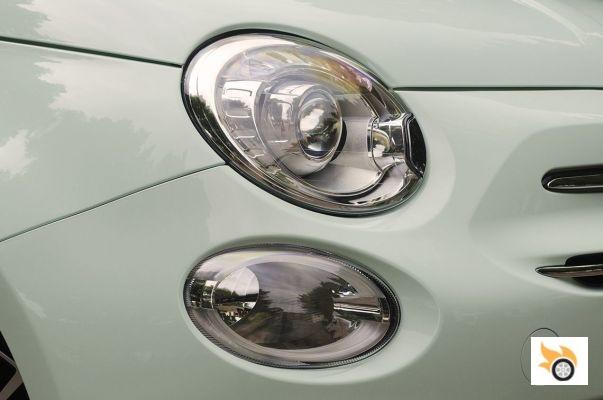
It changes the design of the headlights, and gain a LED daytime running light, but the optional xenon projectors are the same as before.
The front light clusters are new (or almost new), and this is where the most risks and discussions can arise. The circular lower clusters have LED daytime running lights in the form of a "light ring", a solution we're sure everyone will like.
The main headlights are the riskiest. The non-xenon version uses halogen projectors with a magnifying glass framed in a sort of spherical triangle with rounded corners that add three-dimensionality to the look and a "jewel-like" appearance. Personally I will say that the original "transparent" halogens, and the way and manner in which the turn signal followed the cut of the hood, I liked a lot, and I find it hard to prefer the new ones.
On the other hand, the investment has been taken by these headlights, and the xenon version (which illuminates much, much better at night) stays with the design that already had in the main projectors (although it also has the LED daytime running lights). Under the circumstances, as I've told you before, if you do night driving in areas outside the city (without lighting) it's really worth the xenon model, because it has much more capacity.
The whole front end is softened, too, to allow the car to pass the crash regulations that will come into force in 2018, a clear nod to how far the lifespan of this generation of the model may go.
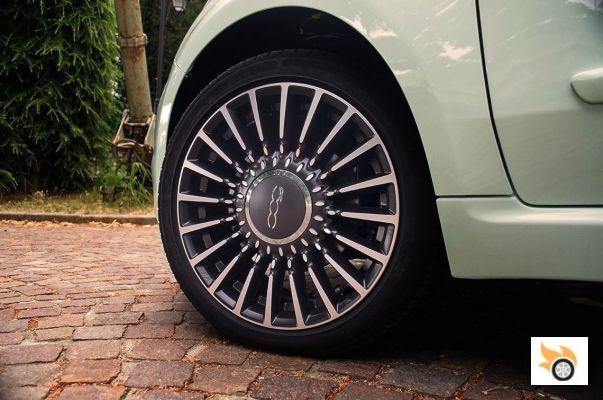
There's new, elaborate wheel rims
Continuing with the aesthetics and moving to the side, we find new alloy wheels that play with three-dimensionality and diamond and black finishes to create new shapes and extremely well cared for sensations. There are two new colours available for the bodywork, and six vinyl finishes called "second skin", which offer the possibility to personalize the look of the car much more, with factory finish and warranty on them.
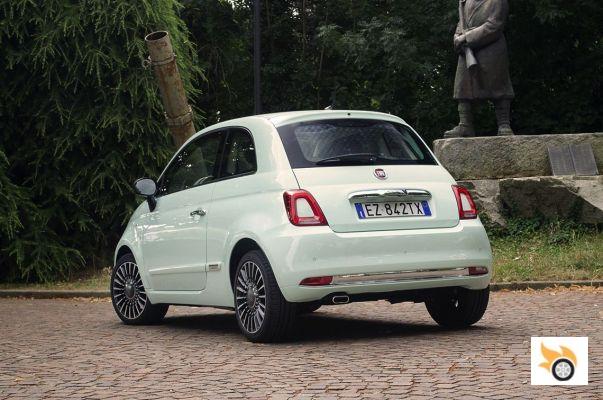
The rear lights, which are not LED, by the way, are undoubtedly the protagonists of the exterior redesign.
At the rear we find the most pleasant surprise, by far, in the aesthetic level, and is that a new perimeter pilots are released, hollow in its central part, revealing a plastic piece of body color. In live they seem to "come out" of the bodywork. They are reminiscent of the original ones in their outline, but are a beautiful nod to modern minimalism. And they work and look good, creating an unmistakable differential night-time identity for the Cinquecento. Curiously, although they look like it, they don't use LED technology, but halogen bulbs and a clever system of reflectors and fibre optics to distribute their illumination.
Due to the lighting needs of these headlights, the fog lights and reversing lights have been moved to the lower part of the bumper, accompanied by a chrome trim in between, and the Cinquecento's typical rectangular and clearly visible exhaust tailpipe.
Cabin
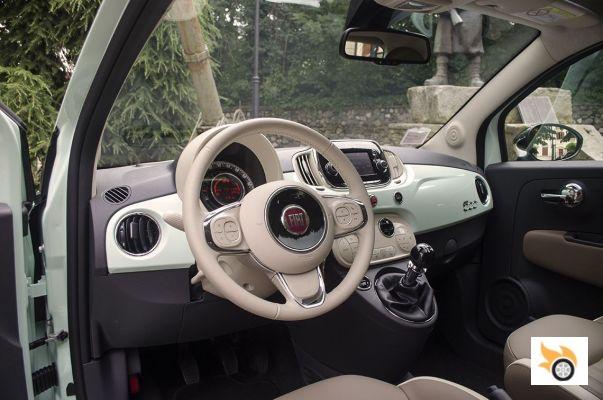
When you open the door, at first glance it may seem that the car has changed little, but it has changed where it was meant to. Eight years ago, the 500 was launched with a state-of-the-art infotainment system, signed by a collaboration between Fiat and Microsoft, under the name of Blue&Me, which promised not only new features at the time (Bluetooth hands-free, MP3 reading via USB sticks, iPod connectivity, voice commands...) but also future updates.
But a year and a bit after the launch of the car, Fiat would acquire Chrysler, and with that a new infotainment system would be established away from Microsoft, under the name of UConnect. The system turned out to be much more powerful and intuitive, but the 500 has been slow to arrive.
Comparisons are odious, but the simple mess one had with the Blue&Me to search for a particular song in the music file on a USB stick detracted a lot, even after switching last year from analogue to digital.
With Twingo, ForFour, Aygo, 108 and C1 integrating the latest generation of touchscreen systems, Fiat had to respond, and it has finally done so by integrating a UConnect solution into the Cinquecento's dashboard. The design of the cabin, as we said, hardly changes to accommodate this new multifunctional screen, which is only five inches, for reasons of space limitation (to keep good air vents and put the rotary controls on their sides). But it really doesn't seem insufficient in any case when it comes to using it.
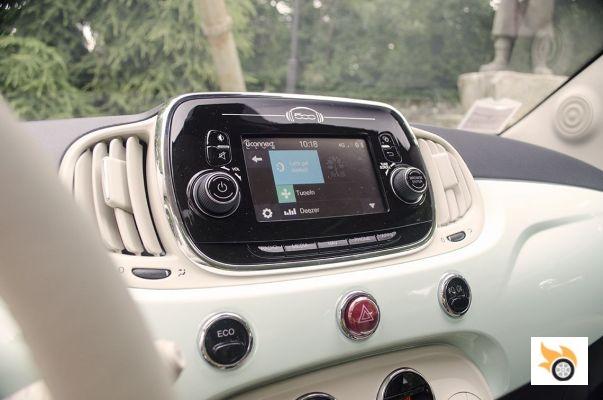
The new infotainment system is the main protagonist of the remodeled cabin.
It is also faster in its software than what we saw in the first 500L, and allows functions of all kinds, from using the GPS to pull online radio with a paired smartphone. Purists may complain about the loss of the original dashboard design, but I'll respond by saying that there's no reason to complain, because aesthetically, live, the system fits perfectly, and the gain in versatility justifies it.
The rest of the interior changes are detail changes. The clock panel can be digital or analog, as was already the case last year. The miniguantera is lost to the left of the steering wheel on the cover that gives access to the fuses, while the glove box in front of the passenger's legs gains a cover, something required by some users. The power windows change for circular ones, and the removable drawer that was on the side of the area where the gearshift goes has disappeared to make way for a mesh to hold the phone.
The dashboard can be digital or analog. The glove box gains cover
Also changes the plastic piece that goes in the tunnel "transmission" (where no transmission passes), with a new integration for connecting USB sticks and auxiliary input. There is a new rectangular and narrow hole perfect to leave the mobile phone, where it does not fly out.
The plastics used in the dashboard, at least in the test unit that we were able to drive for just over two hours, gave me the solution to be a hair worse finished than what had been usual so far in the car. The dashboard, in its lower part, seems to have been taken, in fact, from the Yankee version, to which we had already attributed three years ago a poorer quality of materials and finishes when we had the opportunity to test it.
The steering wheel is also new. The controls integrated in the steering wheel are similar to those of the Fiat Panda and the 500L, but lack the useful knobs to control the volume and so on. Here it's all about buttons. The diameter and finish (leather in our case) are flawless, and everything you touch to drive has a premium feel to it, as does the billiard ball-inspired gear lever, which has a cute finish.
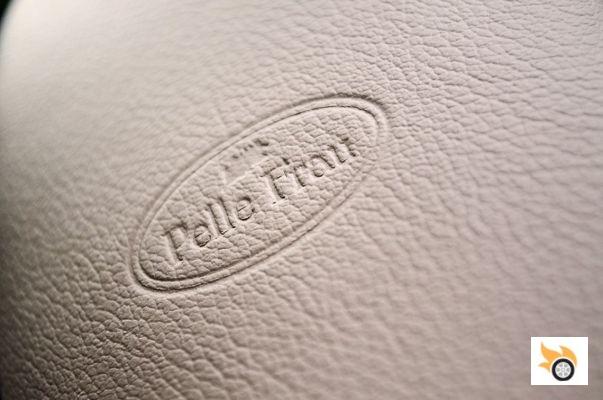
The Frau leather option for the Lounge is simply sensational.
The upholstery deserves a separate mention. All the test units were with the top of the range finish, the Lounge, and ours in particular integrated the optional leather signed by Frau. To talk about Frau leather is to talk about the best leather you can find in the automotive world, and although the 500 doesn't use a "fine" one, they use one that gives the seats the sensation of holding up well over the years, with an excellent feel when you pass your hand over it. Finding Frau leather in an A-segment car is still surprising...
In terms of ergonomics and available space, nothing has changed here. I'll tell you what I've always said: the 500 surprises, as the original did, in terms of its interior to exterior space ratio. Four adults of standard size (1.75) can travel comfortably, incredible as it may seem, as the rear seats have genuine legroom. Where it suffers is in the boot space, which pays a little for the design of the diagonally dropped rear end from the C-pillar, with a capacity of 185 litres. I will tell you that to go shopping or carry a baby stroller (yes, believe it, even my Quinny Mood fits) can serve you, but do not expect much more in a car 3.57 meters long.
The standard audio system will be acceptable, but it's the optional one that gets our attention. Previously offered was an Interscope system, which has now given way to the US 500's Beats Audio with... 440 watts RMS of sound no less. If you like your music rich in nuance and punchy, this is another option to consider.
Impressions with the TwinAir 85 bhp manual
Our route for the morning included a nice mix of city driving around Turin, and a drive through the foothills of the Alps after crossing the Po, where the homes of the more affluent Turinese who can afford it are located. Curvy roads, once used by Carlo Abarth and his team to test their beasts made in Corso Marche, with asphalt always broken by frost and winter snows. We had the perfect place to test a car that is, personally, the one I probably know best of all the cars on sale right now.
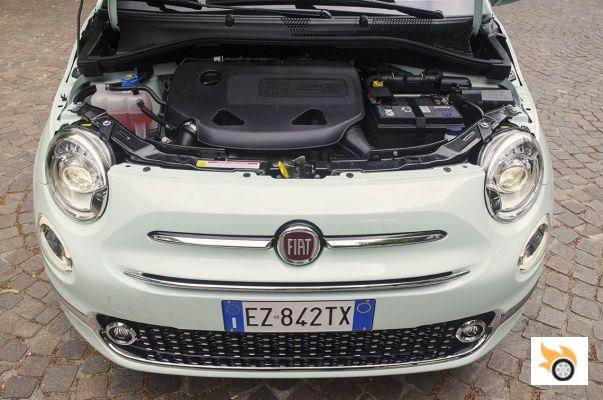
In Spain will come the 85 hp version of the TwinAir engine, which until now was sold with 105 hp.
We chose the 85bhp TwinAir engine with manual gearbox for our test, and were assigned a green colour described as "menthol milk" (don't ask), a colour I don't think I'd ever choose (yellow, on the other hand, drives me crazy). Key in the ignition and start. The TwinAir's unmistakable twin-cylinder sound reaches our ears and cheers our soul. The vibrations at idle have been reduced compared to the conventional TwinAir, and the few that remain are gone as soon as you start driving.
The first few metres reveal a car that has hardly changed at all, but after a few kilometres, the small differences begin to emerge. The steering, one more year, seems to have improved marginally, although the company says it hasn't changed anything. It's now on a par with the Panda, in that it's lost that springy-chic feel when you leave the centre point of the steering wheel but turn a few degrees.
As you get further into the steering wheel you notice that the set-up is more accomplished, especially when you're going a bit fast through corners. The suspension also seems to be marginally improved. Fiat talks about a recalibration of the car, we've found that the dampers seem to control body movements better (either because they are more restrictive, or because the springs have lost a hair of hardness, or a combination of both solutions), as the car bounces less after passing through holes and bumps, and that, when it encounters irregularities in the asphalt in full support, they don't "spit" or move you around either. All in all, it gives a slightly more confident feeling, improving on what the 500 already offered, which was no mean feat. We will have to test the car in detail, in any case, on the highway and on our roads for some more time to draw more concrete conclusions.
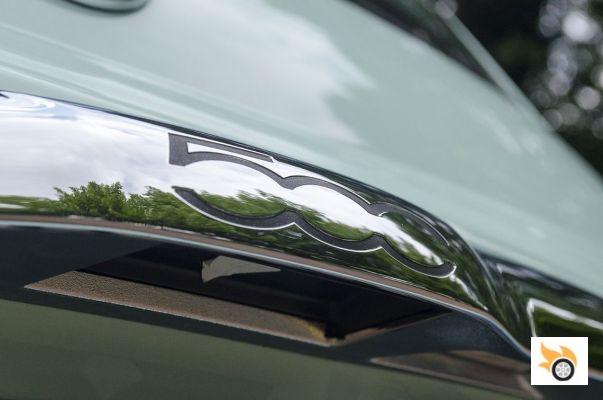
The engine, meanwhile, has convinced us more than on other occasions. In this variant of 85 horsepower promises consumption of 3.8 liters and emissions of 90 grams of CO2 per kilometer traveled, but if you have the hot blood, you will be far from those consumptions, and visit the 5.5 or six liters while you stretch it to the red zone enjoying its peculiar sound. It may not be a lighter driving that way, but it has mid-range torque and hardly any lag, which creates a synchronicity between what you want, what it delivers and what you actually get. The 500 with this engine isn't a fast car, but it feels nimble, I'm not talking about the chassis, I'm talking about the engine, for overtaking or coming out of corners, or driving happily around bends and up mountain slopes.
God knows why, but this engine manages to make you fall in love and convince you, something that rarely happens nowadays, even less in a car of this size. It has "something".
After two hours and some riding in the 500, we got out with the feeling of having tested "the same car as always" slightly improved in chassis and engine delivery, and with the advantage of having finally integrated the infotainment system required by the current times.
Nothing changes with the robotised gearbox
After leaving the manual version aside, I remembered that in the press release it was implied "Italian style" that the Dualogic robotised manual gearbox had been improved in this model, to offer quicker gear changes and a more satisfactory performance. So we took advantage of the little free time we had left to get into a convertible with the sequential gearbox to see if anything had really changed in this gearbox that we didn't like so much in previous occasions.
The nice manual gearbox is the best option, the robotised one still has its shortcomings in its response.
Unfortunately, the first traffic light we came across after leaving Fiat's Lingotto in Turin dashed our hopes. We stopped and the star&stop switched off the engine. When the light changed to green, I put my foot down on the accelerator without contemplation. I could mentally count one, two, three... and that's when the car started to move, slowly, until it managed to clutch and start pushing hard, until it was time to insert second gear, when the car gave us another of those infamous moments, in which the engine stops pushing while the car changes gear in a second and something that becomes eternal time.
It's a shift "as good" as the first and second generation Smart. Well, maybe that's a bit harsh to call it that, but even if it's a hair better than what Daimler was selling in those cars, it's still light years away from what you'd expect from a robotic shifter in 2015. The biggest problem for Fiat is that the Smart ForFour now already employs a much quicker and more pleasant dual-clutch box, which removes that "there's nothing better in the segment" excuse.
Obviously, one would expect the dual-clutch TCT box that FCA has already developed, but to implement it in the 500, at this stage of its life, is an unacceptable investment, so we'll have to wait for the next generation to see it.
Range and technology
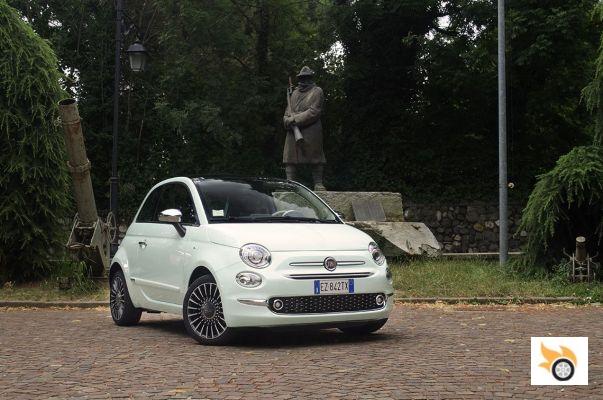
The range in Spain expands in mechanical offerings, but decreases, at least this year, in terms of equipment. The engines are grouped into three versions of the 69 hp 1.2 (petrol, petrol with start&stop and a mixed petrol/LPG), two versions of the 0.9-litre TwinAir two-cylinder (85 and 105 hp) and the 1.3 Multijet diesel with 95 hp. According to our current range data for Spain, the 95 hp diesel would not be available in our market in the first instance. It will arrive a little later, accompanied by an "Eco" variant of the 69 hp 1.2, which integrates an intelligent alternator and changes in the tires to reduce consumption and emissions.
The finishes can be Pop, Pop Star and Lounge, distributed among all of them all kinds of options that you'd better check with the configurator if you are interested in the car. The most equipped model, the Lounge, can also have extra packages (Style and Cult) that serve to finish setting up your car with items such as leather or digital dashboard.
The robotised gearbox is optional, but as I explained above, unless there is a clear need for an automatic, I wouldn't recommend it. The convertible body is offered with all engines except the base 1.2.
Conclusions and buying advice
The 500 has successfully reinvented itself once again. It's still a product that has few rivals in the A-segment in terms of design. Only the Twingo and the ForFour can claim to have enough "personality" to argue with the Fiat on a one-on-one basis. The aesthetic change, although risky, has been clearly satisfactory, and the wide variety of options and colors make you can almost make a custom Cinquecento. We miss the sporty version, but we understand that it will come later.
In terms of performance and mechanics, the chassis has improved, the car bounces a little less, but still sticks to the road, and offers a driving dynamics in the curve to curve that its rivals do not have, without sacrificing at all the behavior in the city, where it is still mousy and extremely capable. The engines are not the most fuel efficient in the segment, that's for sure. I, without hesitation, I would buy a TwinAir. The 1.2 Fire is outdated, and although it's a good option for those who don't want to spend a lot, it doesn't have nearly the character, torque or sound that the 500 requires.
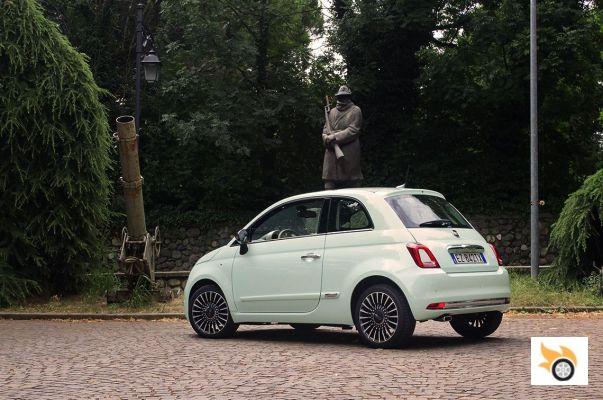
My choice, with the new range in hand, would go for a TwinAir in Lounge trim with the most comprehensive infotainment system.
The diesel, meanwhile, is clunky and unnecessary for a car of this type, unless you're driving more than 35,000km a year in it. So yes, I'd go for a TwinAir. Until now, due to commercial decisions of the brand, only the 105 hp was available in Spain, as it was very close in price to what the 85 hp would cost, but now both variants will be offered.
Testing the 85 hp I have the feeling that it lacks neither power nor panache. The 105 is more powerful, yes, but unless you're going to run around curves and up hills, you shouldn't need that extra, so you could save on the power and apply the price difference in equipment. What I would say, once again, is don't opt for the robotised gearbox. It's not worth it, unless for personal reasons you have no other alternative.
As for equipment levels, since you're buying a 500, it's more cost effective to buy it well equipped. The UConnect touchscreen "Live" system with internet connection and all the other options should be a priority. The digital dashboard, well, maybe not so much. The leather upholstery, besides feeling great, is easier to clean and less hot than the standard textile. Xenon headlights? If you intend to drive at night, they make a huge, seriously, huge difference.
For me it's still by far the best car in its segment, and the obvious choice.
So in short, my "perfect" choice (short of a Sport) would be an 85bhp TwinAir in Lounge trim with the Style and Cult packages integrated. Price? Well, we don't have an official price yet. The car won't be available in Spain until September, but Fiat promises that prices will remain where they are now (from 11.305€), and a variant like the one I'm recommending could be around 15.000€.
If you have a current 500, Fiat also offers the option to deliver it as part payment, and you get rid of paying the down payment and the letters of the first two years, and the third year you choose whether you keep the car paying the remaining value, financing it, or return the car, a formula that should be interesting for loyal customers of the model.
All in all, for me it is still the king of the segment, despite its eight years in the market, and I have the feeling that whoever has to come in 2018 to relieve it is going to have a hard time reinventing itself.
























